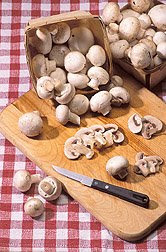Portobello and Other Mushroom Facts
 Portobello and Other Mushroom Facts: Americans love mushrooms, now more than ever. Per capita mushroom consumption in the United States increased from 3.7 pounds in 1993 to 4.2 pounds in 2000. Sales of the U.S. mushroom crop totalled 851 million pounds, and consumers spent $912 million on them. Mushrooms are a good source of selenium, potassium, and copper, and some types have significant amounts of three B-complex vitamins.
Portobello and Other Mushroom Facts: Americans love mushrooms, now more than ever. Per capita mushroom consumption in the United States increased from 3.7 pounds in 1993 to 4.2 pounds in 2000. Sales of the U.S. mushroom crop totalled 851 million pounds, and consumers spent $912 million on them. Mushrooms are a good source of selenium, potassium, and copper, and some types have significant amounts of three B-complex vitamins.
Little-Known Mushroom Facts
- One portabella mushroom has more potassium than a banana; white and crimini mushrooms are also good sources. Potassium helps the human body maintain normal heart rhythm, fluid balance, and muscle and nerve function.
- Mushrooms contain significant amounts of selenium, which plays an important role in the immune system, thyroid system, and male reproductive system. It also works closely with vitamin E to produce antioxidants that help the body fight cell-damaging free radicals.
- Mushrooms are an excellent source of copper, a mineral that the body needs to produce red blood cells and for other functions.
- Mushrooms have significant amounts of three B-complex vitamins—riboflavin, niacin, and pantothenic acid—particularly riboflavin. The B vitamins help release energy from the fat, protein, and carbohydrates in food.
- Truffles, or subterranean mushrooms, are the world's most expensive vegetable. One variety, Tuber melanosporum, can cost between $800 and $1,500 a pound.
- The largest living organism ever found is a honey mushroom, Armillaria ostoyae. It covers 3.4 square miles of land in the Blue Mountains of eastern Oregon, and it's still growing.
Source: USDA, Agricultural Research Service. Photo courtesy of USDA, ARS. Used with permission.
Related articles:
Mushrooms Nutrition Facts





